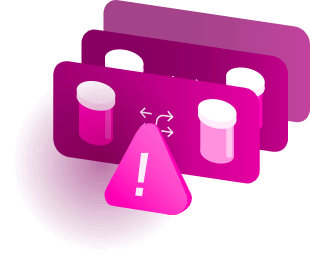Drug Interaction Checker
Overview
DrugBank’s DDI checker allows for up to 5 drugs at a time to be checked against one another for potential drug-drug interactions. For any interactions uncovered, the culprit drug pair is provided alongside a relative severity level:
- minor
- moderate
- major
- And a concise description of the interaction
Each interaction also has an extended description, complete with references, which outlines additional details about the nature of the interaction.
What is a drug interaction?
A drug-drug interaction describes a situation in which one drug affects the activity of another. Drugs may interact with each other to cause side effects that are unexpected or more severe than anticipated. Drugs may also interact and oppose the effects of one another, leading to one (or both) medications not having their intended effect.
Interactions can also occur between drugs and foods or drinks. Some medications benefit from being taken with food while others may work better on an empty stomach. There are some medications that cannot be taken alongside specific foods or drinks - such as metronidazole and alcohol - due to a risk of severe side effects.
Most drug interactions are minor, but some can result in significant harm if not discovered and managed appropriately.
How do drug interactions occur?
Drug-drug interactions can be sorted into two broad categories:
- Pharmacokinetic drug interactions describe instances in which one drug affects the ‘pathway’ of the other through the body - this may involve, for example, preventing the elimination or metabolism of the second drug or preventing its absorption in the first place. Pharmacokinetic drug interactions result in unexpectedly high or low levels of the affected drug in the body and can lead to significant side effects or ineffective therapy, respectively.
- Pharmacodynamic drug interactions describe instances in which one drug alters the actual clinical effects of the other, either positively or negatively. This may involve one drug opposing the clinical benefit of another (e.g. Drug A treats high blood pressure but Drug B increases blood pressure) or two drugs with similar effects working together to cause an undesirable result (e.g. both Drug A and Drug B cause low blood pressure leading to very low blood pressure).
How are drug interactions managed?
Drug interactions are best managed prior to administration. Product labels and monographs often contain information about common or significant drug interactions that should be considered prior to taking the medication and strategies to avoid them.
Drug-drug interaction checkers are also useful in evaluating potential interactions and can be used to check individual drugs or products against one another. Some drug interactions can be managed by stopping one of the culprit medications for a period of time or by taking each medication at a different time of day. Other interactions may require more complicated management strategies involving blood testing or careful monitoring for certain side effects.
